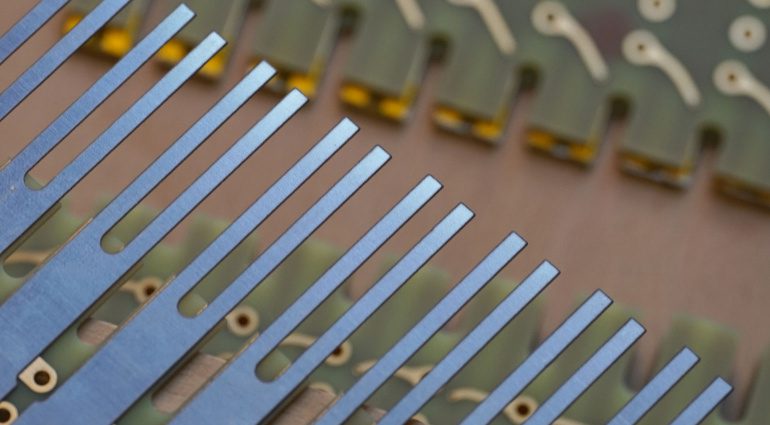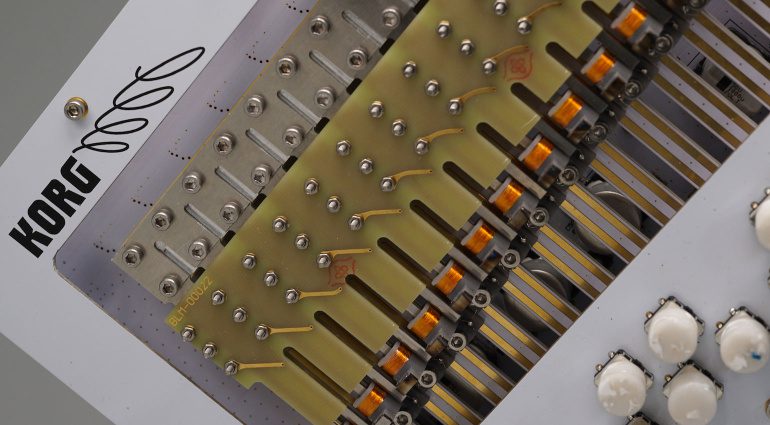Superbooth 23: Korg Berlin to Show New Prototype, Acoustic Synthesis_phase 5 – Update!
New photos and details on the Acoustic Synthesis_phase 5, Korg Berlin’s unusual hybrid electroacoustic synthesizer prototype.
Update 11/5/2023:
Korg has released new photos and information about the Acoustic Synthesis_phase 5, the prototype instrument that its German branch, Korg Berlin, will be showing at Superbooth 23.
According to Korg, the synth is “an early research development prototype. It showcases our newly developed Acoustic Synthesis technology.”
As for what Acoustic Synthesis is, it’s a little complicated, and not having tried it yet I’m reluctant to try to condense the information into something that may be incorrect. Instead, I’m going to let Korg speak for themselves:
What is Acoustic Synthesis?
Acoustic Synthesis unites the sonic richness of real physically vibrating bodies with electronic control.
Why is it special?
Think (of) the strings of a guitar, keys of a xylophone or the air in a flute; embedded into electronic synthesis. The prototype on display demonstrates our latest efforts in merging the physical world with electronics to make instruments that act and feel alive.
What are the physically vibrating bodies?
The vibrating bodies in this prototype are a set of fork-shaped metallic resonators. Their geometries have been tuned so they vibrate at the exact frequencies we would like them to.
How is the resonator made to vibrate?
Very much like in a piano, we hit it with a hammer. Except our hammer is electromagnetic. In technical terms, the scheme we use is called balanced armature, where the resonator is magnetised by a coil to make it move. This allows us to continuously supply energy to the resonators, even when they are in motion.
What does this vibration look like?
If you could zoom in and slow down time, you would see the complexity of the vibrations as the resonator twists, bends and contorts. These simultaneous movements can be broken down into modes. The different modes give each resonator its own unique voice.
How are the vibrations turned into signals?
It’s very similar to how a condenser microphone turns vibrations of a diaphragm into a signal. In our case the diaphragm is the resonator and it sits in air close to some plates held at about 50 volts. Any movement of the resonator causes a small change in the plate voltage. This small change is the signal we want and it contains the beautiful voice of the resonator. We have developed special plate geometries so the most pleasant
and expressive voices can be heard.
How are the signals used?
The signals from the resonators are fed into a feedback system. Here we compare the live signal from the resonator with a target signal we are hoping to achieve. The result of this comparison is fed back to the balanced armature driver, allowing us to compensate for any mismatch between the two signals. This allows us to maintain the electronic control over the resonators while letting them really sing out their beautiful voices.
This is all very heady and intriguing stuff. I’m sure once we can hear it this will make more sense for those of us without PhDs in physics.
It does represent an interesting new take on synthesis, though, and one that will probably see the eventual light of day as actual products and not just theoretical R&D. As Korg says of the Acoustic Synthesizer_phase 5, “It is not a product just yet, but we see Acoustic Synthesis at the core of our future product releases.”
More on Korg
Original post from 9th May:
Korg Berlin Acoustic Synthesis_phase 5
With little fanfare, a cryptic image appeared on Korg Berlin’s Instagram account. It showed what appeared to be a synthesizer without an enclosure, with the photo taken from the side. You could see a few knobs, some white and some marbled, as well as a switch and, inside, some circuit boards. It was accompanied by this text: “Incoming: Acoustic Synth_phase 5.” Is this a new prototype from Korg Berlin? Excite!
Korg Acoustic Synthesis_phase 5: The First Synth From Korg Berlin?
Due to the excitement generated by the image drop, Korg soon followed up with an official press release announcement. This is indeed a prototype for a new sound generation technology, “a form of acoustic synthesis which unites the sonic richness of real physically vibrating bodies with electronic control,” as Korg says in the press release. Real physically vibrating bodies? Super excite!
This will be the first instrument from Korg Berlin, which was founded by former Korg engineer Tatsuya Takahashi, the man behind a number of Korg’s biggest instruments in the company’s history, like the Minilogue, and Maximilian Rest, founder of E-RM Erfindungsbüro. I’ve been waiting to see what they produce and this is already exceeding my expectations.
What Is Acoustic Synthesis?
The press release doesn’t give much information about what acoustic synthesis is but looking at the new image, it appears that it involves electroacoustic sound generation. Sort of like Gamechanger Audio’s Motor Synth, Acoustic Synthesis_phase 5 appears to use physical parts to generate sound. Inside the window on the front panel, there are 12 strips, likely one for each note in an octave. The piano key-like array of buttons below the strips supports this idea. Do they vibrate? Are they struck? That remains to be seen.
What the additional buttons on the front of the Korg Acoustic Synthesis_phase 5 do is also a mystery but we can guess that the one in the upper right is likely volume, with the others changing the quality of the sound.
Korg stressed to me that this prototype is “far from a final product” but it does suggest that exciting things are ahead.
We’re chomping at the bit to hear Korg’s Acoustic Synthesis_phase 5 in action at Korg Berlin’s booth at Superbooth. Expect updates as we get them. If you’re heading to Superbooth, you can check it out too at booth Z440.


More on Korg
- Korg Berlin Acoustic Synthesizer_phase 5: Korg Berlin
- Korg Berlin Acoustic Synthesizer_phase 5: Korg Berlin
- Korg Berlin Acoustic Synthesizer_phase 5: Korg Berlin
- Korg Berlin Acoustic Synthesizer_phase 5: Korg Berlin
- Korg Acoustic Synthesis_phase 5 : Korg
3 responses to “Superbooth 23: Korg Berlin to Show New Prototype, Acoustic Synthesis_phase 5 – Update!”
 4,6 / 5,0 |
4,6 / 5,0 | 




























It might be a stretch, but those look awfully similar to the pickups in a Fender Rhodes. Is this going to be like a synthetic music box or thumb piano or something?
so basically it works like a e-bow. intriguing.
Interesting new way of incorporating the controlled variability of physically resonating material as an element of sound creation – but my immediate reaction is that it would be great if there was a way to customize the sound using user added controlled modifications, like sticking or attaching objects to the vibrating elements i.e. building into this framework the ability to “John Cagefy” the sound to make it unique….